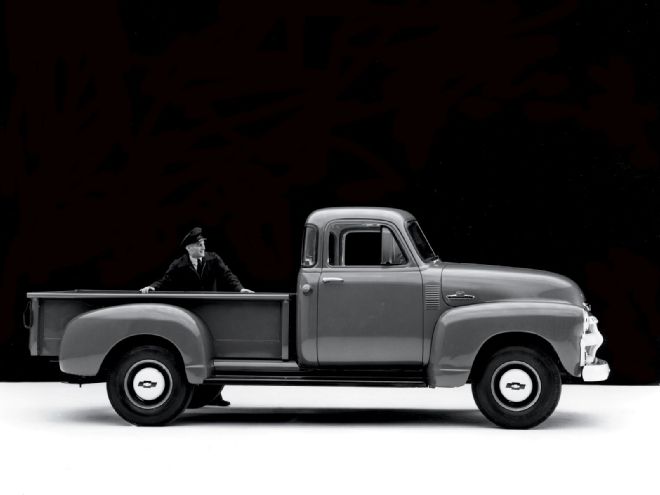
There isn't a hot rodder worth his toolbox who doesn't own or wishes he owned a pickup truck. There are two ways to go about solving this dilemma. There is the late-model Cowboy Cadillac that serves double duty as daily driver and weekend parts chaser, or your latest project is your pickup. We prefer the latter!
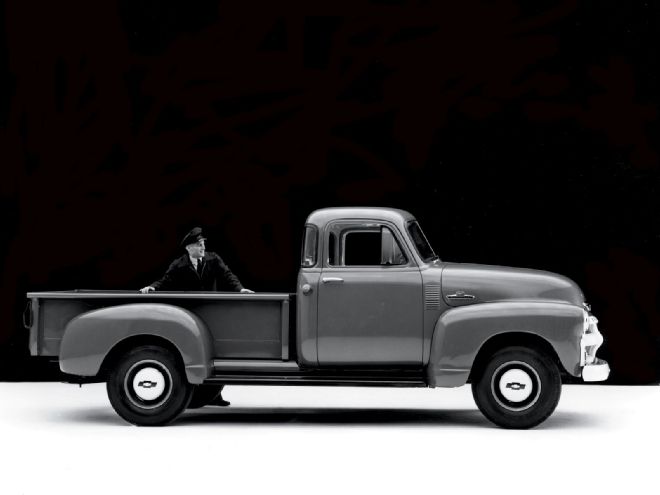 As luck would have it, not only did I inherit the magazine from good ol' Rob Fortier but a ready to rock buildup series, as well. Over the next few months we're going to follow along as our sister publication STREET RODDER's editor Brian Brennan rides roughshod over a cool '47 Chevy shop truck project that, believe it or not, consists of 100 percent aftermarket components!
As luck would have it, not only did I inherit the magazine from good ol' Rob Fortier but a ready to rock buildup series, as well. Over the next few months we're going to follow along as our sister publication STREET RODDER's editor Brian Brennan rides roughshod over a cool '47 Chevy shop truck project that, believe it or not, consists of 100 percent aftermarket components!
Over the following months we are going to build a pickup at the shop of Hot Rods by Dean in Phoenix, Arizona. We are starting with fresh sheetmetal but, as we all know, there is no shortage of '47-54 Chevy pickups, especially the half-ton (Model 3100 Thrift-Master) variety in either the utilitarian three-window or deluxe cab five-window. (Early sales literature proclaimed that the optional curved glass windows: "Promote greater safety by eliminating the blind spot at the rear corners.") In the '40s the top-selling truck was the Chevy and after World War II it was the first truck to get a complete makeover. In May of 1947 the new Advance Design line of Chevy trucks were introduced with the first sales coming on June 28, 1947. There were over 335,000 trucks sold during the 1947 model year, but one should note the old '46 design was sold until May of '47, slightly confusing the actual number of the Advance Design debut.
According to Chevrolet archives, the '47 pickup design was in progress under the direction of the famed GM designer Harley Earl back in 1942. Early trademark design cues included the integrated headlights built into the front fenders, tall hoods, and the split windshield.
These new pickups came in a Forester Green as the standard color accented with a cream pinstripe on the belt molding following along the painted grille bars and then circling the chromed hubcaps. (Chromed grille bars were optional). There were other no-added cost color options that included a lighter shade of green, red, white, maroon, black, orange, beige, and two shades of blue; all came with contrasting pinstripes.
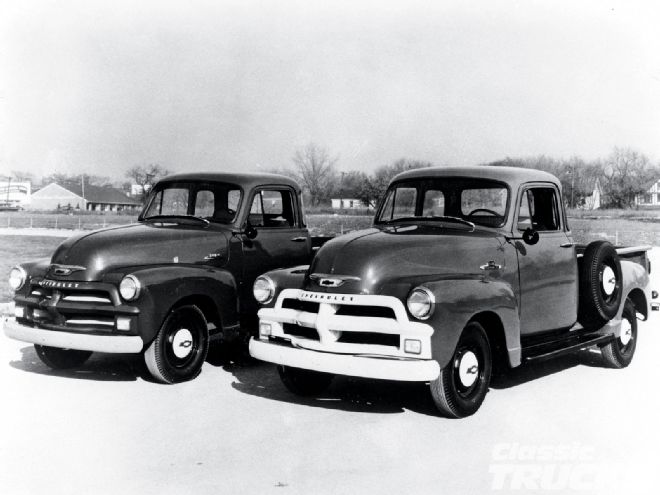 That's right, no messing with rusty old tin for that guy, just fresh new components from a huge and high-quality classic truck aftermarket. So check out this Part 1 intro and keep your eyes peeled for the balance of this way-cool build.
That's right, no messing with rusty old tin for that guy, just fresh new components from a huge and high-quality classic truck aftermarket. So check out this Part 1 intro and keep your eyes peeled for the balance of this way-cool build.
The Deluxe cab (or De Luxe, we have found it spelled both ways in early Chevy literature) was identifiable immediately due to the corner windows. However, there were also brightwork windshield and window garnish moldings, a seatback trim panel, driver's armrest, passenger-side sunvisor, and the before mentioned chromed grille bars.
While the trucks were completely redesigned after the war, mechanically they were pretty much the same. The wheelbase increased from 115 to 116 inches, the same overall frame design was kept, but this time heavier duty framerails were used, and the engine was the venerable inline-six.
As mentioned, plenty of these pickups are around to this day but they were work trucks, and as such lead a rough-and-tumble life. In other words, they all need something. And that brings us to our Project Shop Truck. We could have started with a piece of vintage tin and worked our magic from there and why not, many a hot rodder has done it. Instead, we opted to go with new tin to show how you can start with nothing and end up with something.
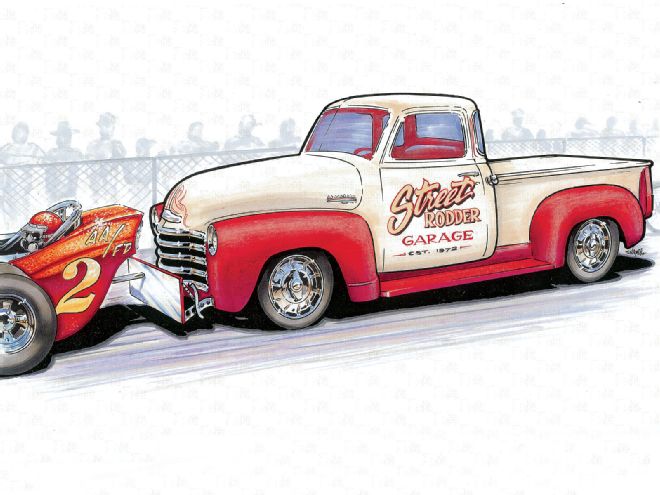 This Josh Shaw illustration depicts one of the efforts we can see from our Project Shop Truck, working as a push truck for one of the local cackle fest events.
This Josh Shaw illustration depicts one of the efforts we can see from our Project Shop Truck, working as a push truck for one of the local cackle fest events.
To begin this project we contacted Chevs of the 40's and lined up all the appropriate sheetmetal that's produced by Dynacorn Classic Bodies. (We did roundup the bed from Mar-K Quality Parts complete with a bed wood kit but more on that later.) The chassis is a freshly squeezed Fatman Fabrications assembly complete with Mustang II IFS, all the appropriate mounts, and a Currie prepped 9-inch rearend. Of course, you can jump in on this project at anytime and take the information that will be used here and apply it to your vintage tin project. But should you find yourself needing any of the sheetmetal, chassis components, interior or exterior trim pieces, then pay close attention as somewhere in the series you will find just what you need.
Our project is based on the following core components: a cab, a bed, fenders, running boards, and a hood, all wrapped neatly around a chassis with the appropriate powertrain.
Body
We selected the Dynacorn Classic Bodies '47-50 Chevy cab (PN TR47PU), and it should be noted that there is also a '52-54 cab as well, but no '51.
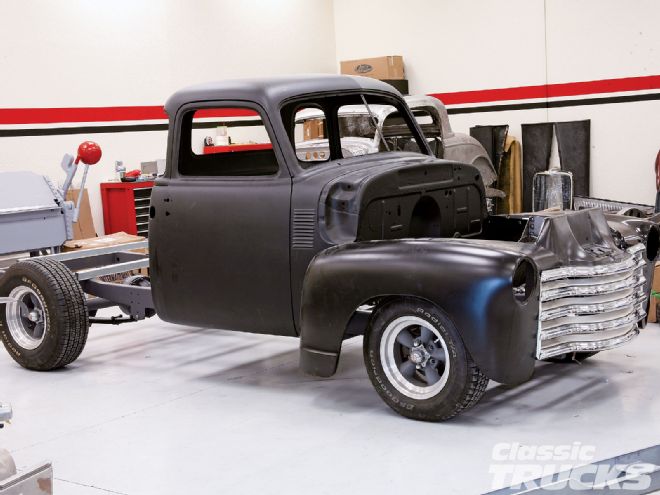 The cab and subsequent sheetmetal came from Chevs of the 40's. You can order it all or in pieces to suit your build. Hot Rods by Dean will be in charge of getting our pickup on the road.
The cab and subsequent sheetmetal came from Chevs of the 40's. You can order it all or in pieces to suit your build. Hot Rods by Dean will be in charge of getting our pickup on the road.
The bodies are licensed restoration parts from GM and completely assembled from the firewall to the taillamp panel, and from the framerails to the windshield frame. The steel used in the cab is 1006 universal automotive-grade steel. In most cases the gauge will be thicker than that of the original. The steel possesses fewer additives allowing it to be a bit more flexible and workable than the original.
The pickup body includes most of the structural parts, brackets, and braces welded in place, plus doors and decklid already assembled. Yes, there will be bodywork and adjustments to be made but far less than starting with a 50-year-old piece of vintage tin, and when it's complete you will have fresh sheetmetal that will last for years to come.
Granted you may have a good cab that just needs a new floor, or firewall, or doors but now you have options. You can order these pieces through Chevs of the 40s one at a time or you can start fresh. Either way takes into account your budget, degree of craftsmanship, and available time. The cab comes with a new firewall (with or without factory air conditioning) to taillamp panel; fitted, assembled and welded.
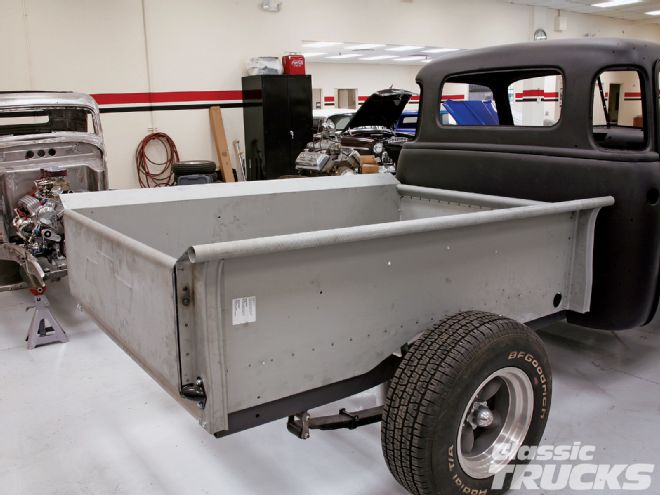 The bed comes by way of MAR-K and includes a bed wood and a custom tailgate.
The bed comes by way of MAR-K and includes a bed wood and a custom tailgate.
Frame
We selected a Fatman truck chassis, which is built from 2x 5x0.188-wall steel tubing, fabricated on precise fixtures built from original frames. All mounts for the body, bumpers, radiator, running boards, and bed mounts are provided. (Fatman does offer another frame outfitted with different radiator mounts for the GMC '47-55 First Series pickups allowing for the larger GMC inline-six).
The standard front suspension uses Fatman's Stage II, with polished stainless steel control arms, urethane bushings, fullsize disc brakes, manual rack-and-pinion, and conventional separate coil springs and shocks. Cast-iron front disc rotors and calipers are standard in either '75-80 11-inch Ford Granada rotors or '68-74 Nova 11-inch rotors for Chevy pattern. (With our project we opted for a power rack-and-pinion and the Chevy bolt pattern with the '68-74 Nova 11-inch rotors).
Make sure to specify which motor you want to use, as there is a myriad of motor mounts from the always popular small-block Chevy and Ford, to the Ford Windsor, FE, 460 engines, and the big-block Chevy. You can also have trans mounts for the popular accompanying automatic transmission. Fatman offers a custom service available for the current crop of modular engines, such as the Ford 4.6L and 5.4L that are adapted to Windsor side-mount insulators. (Check with Fatman when wishing to install one of the modern V-8s, as you may have to supply certain parts for dimensional purposes. The same holds true for manual transmissions, which are generally setup to use a hydraulic clutch mechanism.)
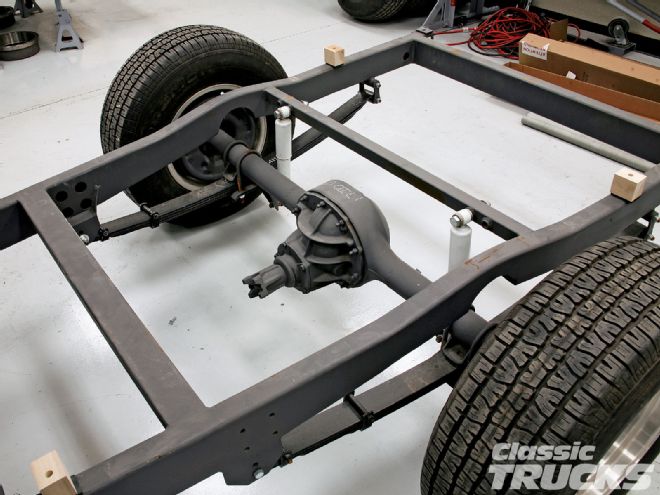 The rear of the Fatman chassis is a leaf-spring unit complete with a Ford 9-inch rearend.
The rear of the Fatman chassis is a leaf-spring unit complete with a Ford 9-inch rearend.
Your Fatman chassis will come with a lacquer-based primer to prevent corrosion. This will serve you well; we have had ours for over a year now with no rust, and it will take you through the fitment phase. Fatman expects you to sand the bulk of that primer off during the paint prep process. Another primer paint option is an epoxy primer finish. Fatman sands all the mill scale off the steel after subassembly parts are fabricated, and before final weld assembly. According to Fatman, this provides an excellent base for finish paint, and is even used as a final finish for road use, as it is waterproof. It will fade over time, so finish paint is recommended.
A Word On Registration
There are 50 states and about 50 different ways to register your '47 Chevy pickup. The most common are as a replacement body for an existing VIN, a special construction vehicle, or a series of hybrid ways depending upon the state you live in. For instance, in Idaho where they have a Street Rod License and Registration law all you need to do is provide proper paperwork (the Manufacturers Statement of Origin, MSO, provided by Chevs of the 40's, via Dynacorn, and Fatman will do the trick) and throw in receipts for the drivetrain and you will leave the DMV with a registered truck.
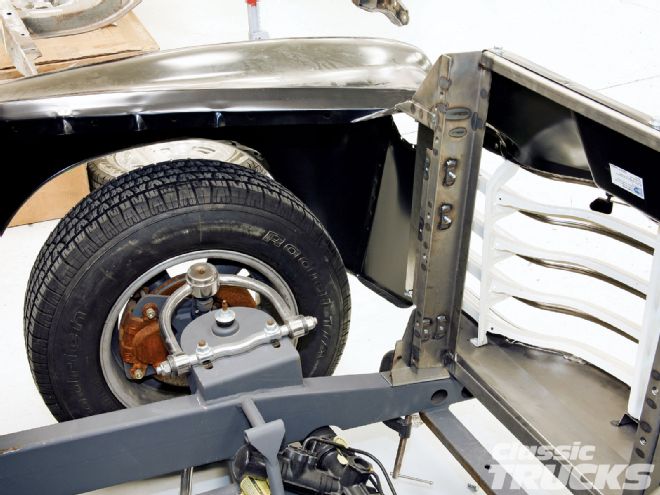 The front suspension is the always popular MII with stainless steel control arms, Chevy bolt pattern and GM disc brakes, and optional power rack-and-pinion.
The front suspension is the always popular MII with stainless steel control arms, Chevy bolt pattern and GM disc brakes, and optional power rack-and-pinion.
Unlike cars, trucks in many states will require weight certificates and may also need to be registered as commercial vehicles. The registration will cost a few more bucks but nothing that would seriously impact your budget.
Many states will allow you to title your pickup as the year it most closely resembles, in our case a 1947, and inspect it as that year. This is the typical process in those 17-plus states that have the Street Rod and Kit Car registration laws, resulting from the efforts of SEMA through the SEMA Action Network, local car clubs, and individuals. Other states will require you to title it as the year the chassis was built, and inspect it as to the year of the engine used, which is one of the hybrid methods mentioned earlier. Although in current dispute is the State of California, interpret that as confusion, should you have a Chevy 350 you can register it based on the "family" of engines that the 350 represents which was first brought out in '67-in Camaro's.
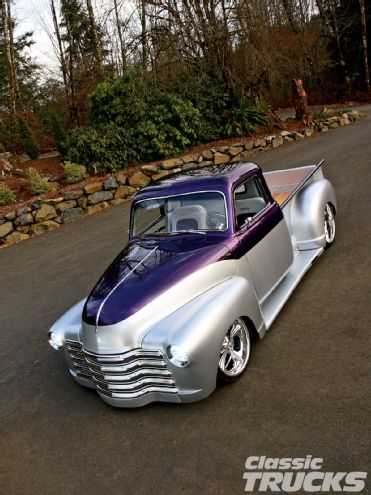 You can build your '47-54 Chevy pickup in any number of ways, but this excellent example of a well-finished and detailed pickup belongs to Chevs of the 40's.
You can build your '47-54 Chevy pickup in any number of ways, but this excellent example of a well-finished and detailed pickup belongs to Chevs of the 40's.
The Fatman chassis comes with an MSO. Their MSO and the 17-digit VIN number will assist you in getting a proper title from your local DMV. Fatman is listed with the federal government as a legal manufacturer and its MSO is the same paperwork provided with any new car. It is a violation of federal law for anyone other than the original manufacturer to supply a VIN number or to stamp one onto the chassis or elsewhere on the body. Should you purchase a chassis from Fatman make sure to request this service before taking delivery as they cannot supply the number at a later date for you to stamp into your chassis.
When you order your '47 Chevy pickup from Chevs of the 40's a MSO for an Automobile Body is provided through Dynacorn and the paperwork lists a serial number, year of truck, and other pertinent information. You will find this makes registration a great deal easier.
Next Up
Over the next few months we will get into the mounting of the cab, fenders, and running boards. We will also start from scratch with the building of a pickup bed from Mar-K out of Oklahoma. You will see, as we did, that building out the interior is quit simple. Chevs of the 40's has all the pieces, and the cab will accept all of the original or aftermarket pieces intended for this truck, since it is built to replicate the original.
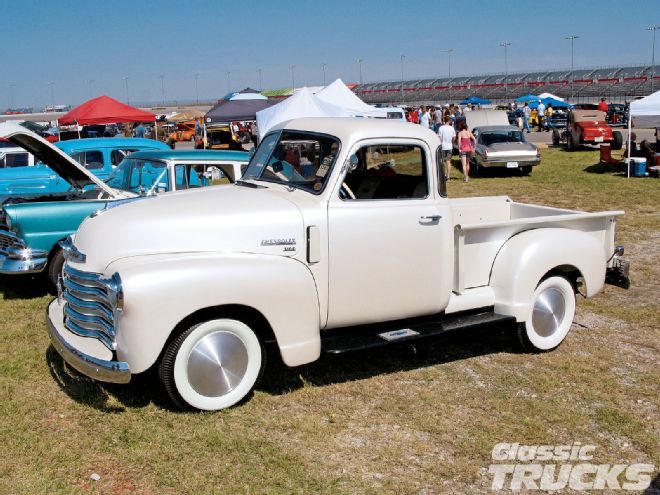 This five-widow has the mild custom touch with wide whites, Moon discs, and flat paint.
This five-widow has the mild custom touch with wide whites, Moon discs, and flat paint.
Project Shop Truck is off and running. Now let's see if we can get it running in time to have some fun this year.